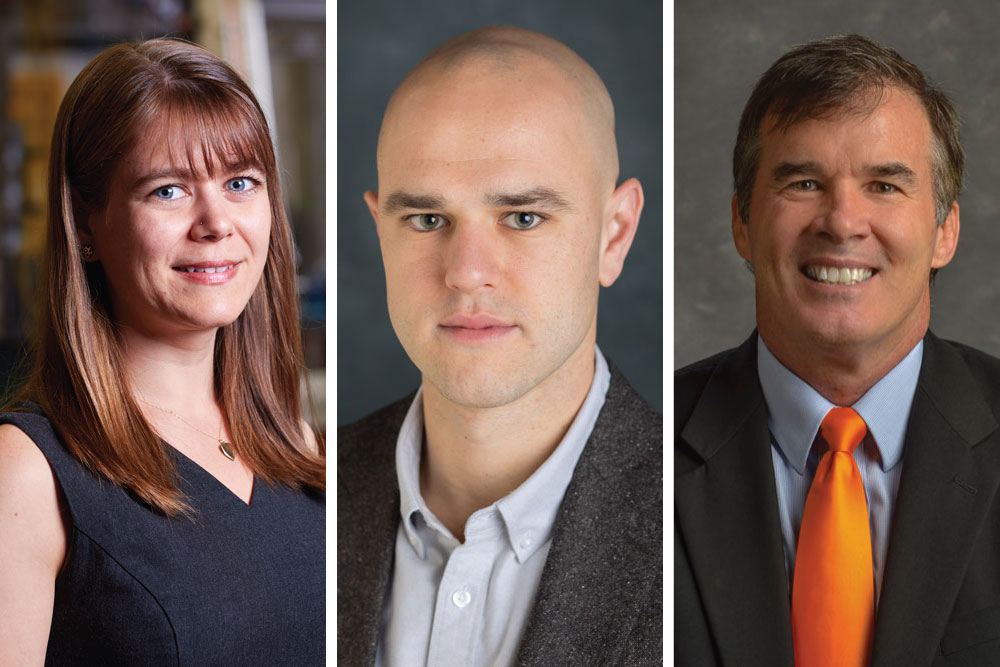By David Goddard

Left to right: Jamie Coble, Vladimir Sobes, and Wes Hines
The US Department of Energy created its Nuclear Energy University Program to help the country retain its leadership role in nuclear research by providing funding opportunities for faculty and students across the country.
In addition to UT students who have received undergraduate and graduate student awards through the program, three nuclear engineering faculty members recently had initiatives selected for support totaling nearly $5 million. Each of the project teams include multiple department members.
“We are very proud of our faculty and their accomplishments in helping make this department one of the best in the country,” said Postelle Professor, Chancellor’s Professor, and Department Head Wes Hines, who leads one of the projects.
Southern Company Faculty Fellow, and Associate Professor Jamie Coble leads the project, “Developing the technical basis and risk assessment tools for flexible plant operation,” along with Associate Professor Nicholas Brown and researchers from other institutions.
Familiar Faces
Interestingly, two of the collaborators on the project from Idaho National Lab are UT alumni.
Research Scientist Vivek Agarwal got his master’s in electrical engineering in 2005, and Postdoctoral Researcher Cody Walker earned his bachelor’s, master’s, and doctorate in nuclear engineering in 2015, ’17, and ’20, respectively.
It was chosen as a DoE Integrated Research Project, one of just seven so designated in the country. They typically are made up of a group of universities and research entities and offer the capabilities of DoE labs. They also come with multi-million-dollar funding, in UT’s case $4 million.
Accordingly, they also aim to tackle in-depth problems. In this case, the goal is to further expand nuclear’s important role in fighting climate change by exploring the use of nuclear plants in other “green” areas like hydrogen production, desalination, and production of petrochemicals and synthetic fuels.
“Our goal is to explore new ways of thinking about what a nuclear plant in the currently operating fleet can accomplish outside of its traditional, baseload power-producing role,” said Coble. “This project will help further increase the impact that nuclear energy can have on meeting and exceeding our climate goals, as well as providing a safer, cleaner alternative to the production of some materials that now are done via chemical plants in many cases using electricity and heat produced through ‘dirty’ means.”
The next project is led by Assistant Professor Vlad Sobes, “Extending the HMF71 Benchmark Series for Graphite Reflector Thickness up to 18 Inches.” It also includes department Hall of Fame inductee John Mihalczo, among other researchers, and is part of NEUP’s Research and Development Awards.
Their goal is to extend the knowledge gained by a series of tests conducted under the International Criticality Safety Benchmark Evaluation Project.
Those tests created a data set that focused on how graphite reflectors affected criticality. Only reflector thicknesses of one and two inches have been studied so far.
What Sobes and his team hope to do is gain a deeper understanding of nuclear reactions in graphite by analyzing the data for critical experiments with graphite reflector thicknesses between three and 18 inches. They gained funding of $400,000 as part of the effort.
“There is real history with these original tests that we felt was at risk of being lost, so the first thing we want to do is make sure that gets saved,” said Sobes. “Also, trying to reproduce these tests today would be very cost prohibitive. By accessing the historical data, we can extrapolate out what the results would be for some currently proposed advanced nuclear reactors.”
Led by Hines, the third project is, “Construction of a Flexible Fast Flux Facility for Cross Section Measurement, Benchmarking, and Education.” Part of NEUP’s Infrastructure Grants, it also includes Sobes, Assistant Professor Sandra Bogetic, and UCOR Fellow and Professor Jason Hayward.
The heart of this project also lies in the heart of how the new Zeanah Engineering Complex can help the department with its massive new research spaces, in this case the Fast Flux Facility (FFF).
Through the FFF, Hines and the team will be able to experiment with many different reactor designs, develop new ones, and make them more financially advantageous overall.
“Modeling and simulation are critical in the design and licensing of advanced nuclear reactors, but there is a shortage of data, resulting in model uncertainty requiring more conservative designs,” said Hines. “The FFF will allow us to fill in those gaps, resulting in more cost effective and fiscally competitive designs.”
That project is receiving $319,000 in support.